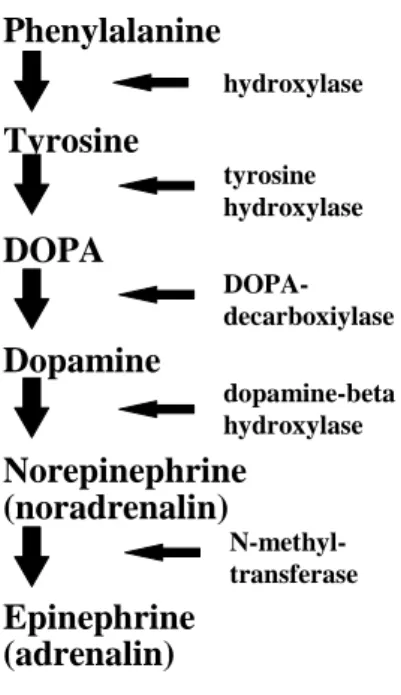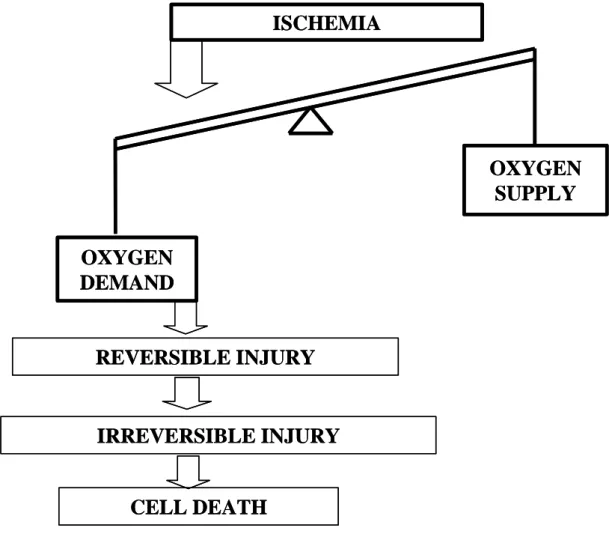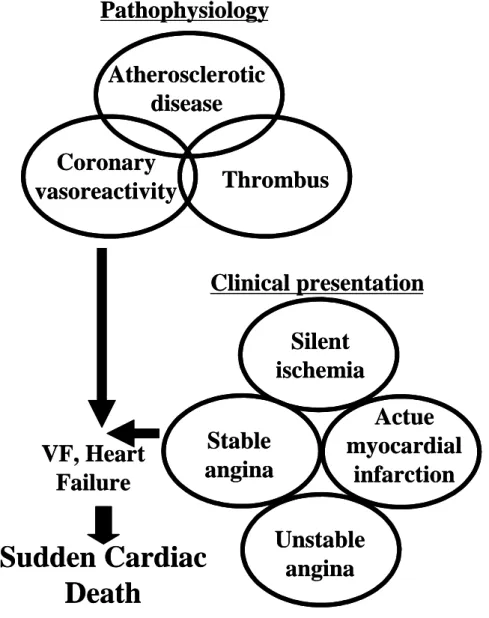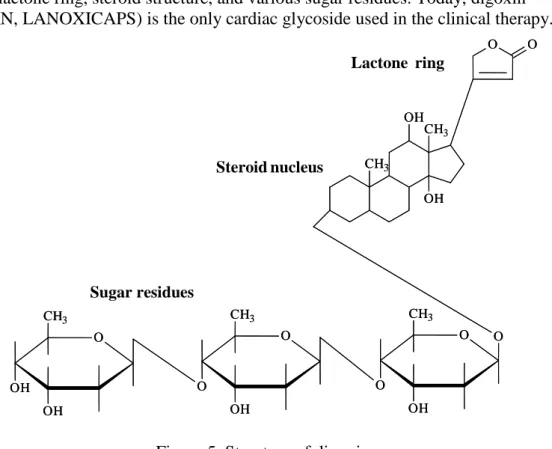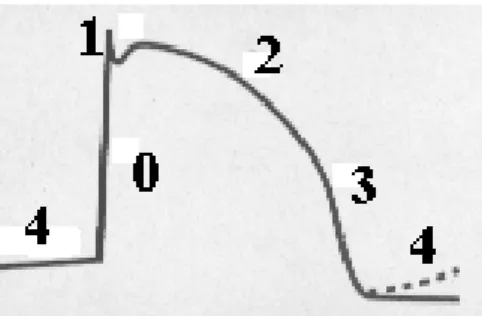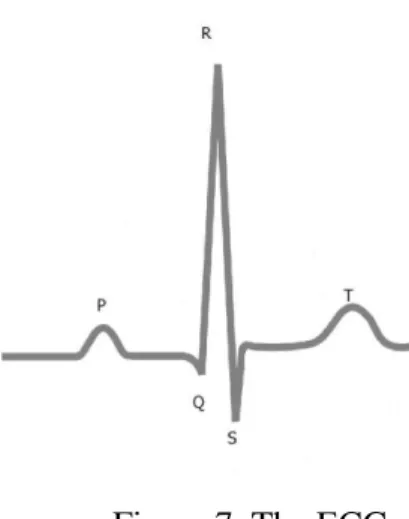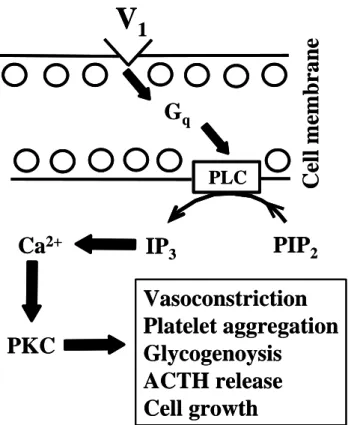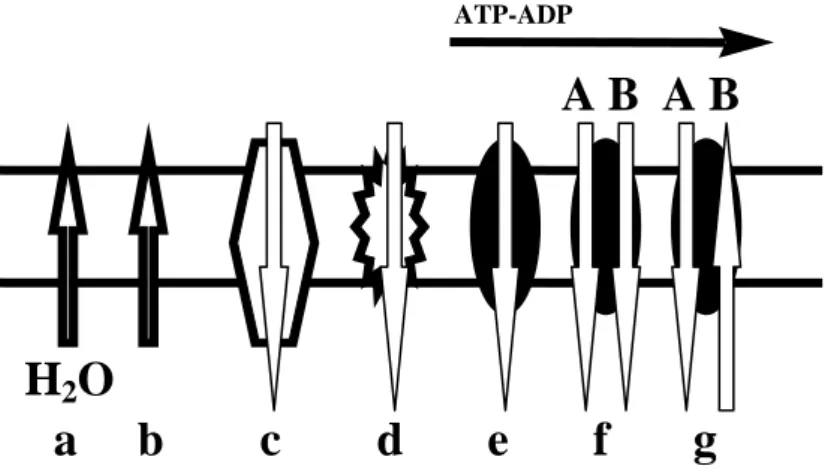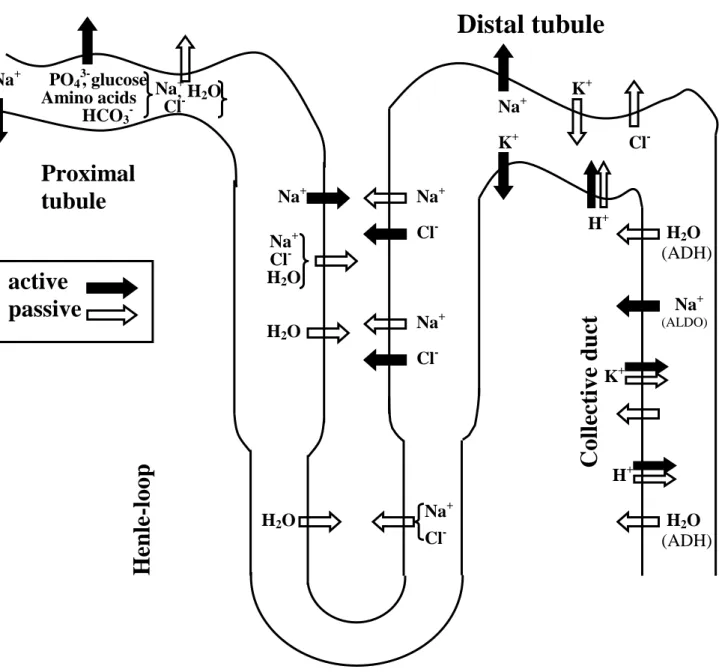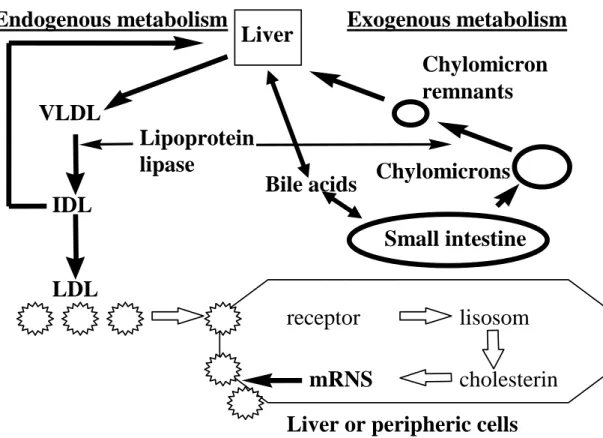SELECTED CHAPTERS OF PHARMACOLOGY
SELECTED CHAPTERS OF PHARMACOLOGY
Prof. Dr. Árpád Tósaki
Publisher• Budapest, 2011
© Árpád Tósaki
closed: 2011. okt. 31.
ISBN Publisher
Responsible:
Responsible Editor:
Editor:
Extent:
SELECTED CHAPTERS OF PHARMACOLOGY
Written by
Arpad Tosaki 2011
University of Debrecen Helath Science Center
School of Pharmacy Debrecen HUNGARY
Reviewed by
David Donald Haines
University of Connecticut, Storrs, CT
USA
PREFACE
This book was written to provide students, researchers and educators with a user- friendly tool for keeping pace with rapidly evolving drug discovery initiatives. The primary content is based on the pharmacotherapy of various diseases, which has been an enormously rewarding and fascinating adventure. In addition, the content is also based on my research and teaching experience during the 3 decades prior to this writing in Hungary, England, France, and United States of America, which has been an enormously rewarding and fascinating adventure. Use of pharmacological agents to prevent or mitigate disease is an ancient skill maintained during the entire history of all human societies in various forms. Hunter-gatherer communities each developed culturally unique uses for plant, mineral and animal resources locally available to populations in need that evolved into sophisticated and increasingly efficacious medical traditions that persist to this day. The progressive integration of medical traditions into written record allowed evolution of progressively powerful pharmacology based increasingly on analysis of clinically valid precedent. As understanding of the molecular-biological basis of diseases, drug design has become progressively driven by consideration of how specific biochemical interactions may be modulated to achieve therapeutic endpoints. Of particular interest in this respect, is identification of compounds capable of modifying critical ligand-receptor interactions, enzyme activities and other events in cellular signaling pathways that lead to enhancement or inhibition of major symptoms of various diseases. Most descriptions of drug mechanisms given in this book focus on how small-molecule drugs affect specific molecular targets to alter well-defined aspects of cellular physiology in ways that in most cases are expected to result in improved prognosis of selected disorders. In this respect, the book reflects “orthodoxy” of strategic thinking in the pharmaceutical industry, which favors single site-acting “magic bullet” compounds that may be highly effective in some treatment venues, but are highly toxic, often costly and provide
only transitory remediation to serious chronic illness. A particularly exciting subject area covered in this book is a description of novel treatment strategies that prevent or mitigate serious diseases, particularly those with underlying inflammatory etiology, by strengthening natural host immunoregulatory mechanisms, rather than intervening in activity of host homeostasis. It is an honor and a pleasure to participate in the medical revolution, of which this book is a vanguard.
Debrecen, 2011. Oct. 31.
Prof. Dr. Arpad Tosaki
Chairman, Department of Pharmacology Faculty of Pharmacy, Health Science Center University of Debrecen
Debrecen, Hungary
CONTENTS
CENTRAL NERVOUS SYSTEM 7
General anesthesia 7
Intravenous anesthesia 9
Anesthetics for inhalation 11
Local anesthetics 13
Hypnotics and sedatives 17
(A) Benzodiazepines 17
(B) Barbiturates 19
( C ) Miscellaneous sedative-hypnotics 19
Depression and anxiety disorders, drugs 19
Psychosis and mania 22
Epilepsies 24
Mechanisms of seizures and antiepileptic drugs 25
(a) hydantoins 26
(b) barbiturates 26
(c) iminostilbenes 27
(d) succinimides 27
(e) valproic acid 27
(f) benzodiazepines 27
(g) other antiseizure drugs 28
Degenerative disorders 28
PD Diseases (paralysis agitans or shaking palsy) 29
Alzheimer‟s disease (AD) 32
Hungtinton disease (HD) 32
Amyotrophic lateral sclerosis (ALS) 33
Opioids 34
Effects of opioids 34
Morphine and opioid agonists 35
Opioid agonist/antagonists 37
Antitussive agents 38
CARDIOVASCULAR SYSTEM 40
1). Therapy of myocardial ischemia 40
(a) Nitrovasodilators 41
(b) Beta-adrenergic receptor blockers 43
(c) Calcium channel blockers 43
(d) Antiplatelet, antiintegrin, and antithrombotic agents
combined with statins 44
2). Treatment of congestive heart failure 45
3). Antiarrhythmic drugs 50
4). Treatment of hypertension including the rennin-angiotensin system 56 5). Vasopressin and others affecting renal function 59
6). Diuretics 64
7). Therapy of hypercholesterolemia and dyslipidemia 70
8). Blood, pharmacology 74
(I) Hematopoietic growth factors 75
(II) Drugs effective against anemias 77
(III) Vitamin B12 and folic acid for the treatment of megaloblastic
anemias 80
CANCERS AND ANTINEOPLASTIC DRUGS 82
A). Alkylating agents 83
B). Antimetabolites 86
C). Natural extracts and products, and antibiotics 88
D). Miscellaneous agents 90
E). Hormones and Hormone-like agents 95
GASTROINTESTINAL TRACTS 99
(i)The stomach 99
a). Inhibitors of the proton pump (K+ -H+ pump) 100
b). H2 receptor antagonists 100
c). Antacids, ascid supressants and cytoprotectants 100 (ii) The bowel motility, laxatives, antinauseant,
and antiemetic agents, billary and pancreatic diseases 101
Bowel motility 101
Laxatives 102
Antinauseant and antiemetic agents 105
Billary and pancreatic diseases 108
(iii) Treatment of inflammatory bowel disease 108
ASTHMA AND PULMONARY PHARMACOLOGY 112
a). Beta adrenergic agonists (beta sympathomimetics) 114
b). Methylxanthine (e.g., theophylline) 115
c). Muscarin receptor antagonists 116
d). Corticosteroids 117
(e). Other asthma and COPD mediator antagonists 119
(f). Immunomodulators 119
(g). Other future developments in asthma therapy 120 (h). Therapy of pulmonary arterial hypertension 121 ENDOCRINOLOGY, HORMONES, AND HORMONE ANTAGONISTS 123
The hypothalamic-pituitary endocrine system 123
Somatotrophic hormones: growth hormone (GH) and prolactin (PR) 124 Glycoprotein hormones: TSH and gonadotropins 127 Oxytocin and vasopressin (posterior pituitary hormons) 129
Thyroid and antithyroid drugs 130
ESTROGENS AND PROGESTINS 137
Estrogens 137
Progestins (gestogens, progestogens) 140
Anitprogestins and progesteron receptor modulators 141
Contraceptives 141
Testosterone and other androgenes 142
Antiandrogens 143
ACTH (adrenocorticotropic hormone) and adrenal steroids 144 Inhibitors of the biosynthesis of adrenocortical steroids 146
CENTRAL NERVOUS SYSTEM General anesthesia
General anesthesia depresses the central nervous system (CNS) at a sufficient degree to permit the performance of various surgeries and other noxious or unpleasant procedures.
General anesthesia has low therapeutic indices, and therefore, it requires great care in application. Although, general anesthetics produce a very similar anesthetic state, they are relatively dissimilar in their adverse effects in various organs. To choose specific drugs and routes of administrations to produce general anesthesia is based on their chemical and pharmacological properties and on the adverse effects of various structures, in the context of suggested diagnostic and surgical procedures with considerations of the patient‟s age, conditions, and medications. Anesthesia usually is not carried out with a simple agent, thus, anesthesiologists apply various combinations of sedatives, neuromuscular blocking agents, and local anesthetics, as the actual clinical situation requires. The development of general anesthesia and the application of anesthetics started in 1846 in the United States.
The first used anesthetic was (i) „ether anesthesia‟ achieving a revolution worldwide in surgery and medical care. Currently ether is not used in medical care, but it was the „ideal‟
pioneer anesthetic which was relatively nontoxic to cells and organs. Furthermore, ether does not compromise, in therapeutic doses, respiration and circulation. However, ether is not used any longer in medical care, because it forms toxic peroxides in the presence of oxygen and light, and ether is explosive.
Chloroform (ii) followed ether, introduced by a Scottish doctor, J. Simpson, in 1847, as the next anesthetic used worldwide as a nonexplosive anesthetic. The chloroform molecule contains halogens (Cl-), therefore it has hepatotoxic and cardiovascular depressive effects.
Nitrous oxide (N2O) was the third (iii) and „light‟ anesthetic introduced in medical care started in 1868. N2O cannot alone induce „deep‟ anesthesia allowing brain, cardiac or abdominal surgery, however, it was used for painless tooth extraction.
About sixty years later, in 1929, (iv) cyclopropane was discovered and used for the next 30 years. This molecule was explosive and flammable. Therefore, British scientists developed a new chemical structure, (v) halothane, which is nonflammable and possessing anesthetic properties. Halothane was introduced in surgery as a general anesthetic agent in 1956, and since then it has been widely used for general anesthesia.
Principles of anesthesia:
a). Minimizing the harmful effects of the procedure (techniques) and agents.
b). Stabilize and sustain the homeostasis during surgery related to blood loss, metabolic shifts and coagulation.
c). Improve postoperative recovery and treat surgery-induced stress responses.
Anesthesia and hemodynamics:
Anesthesia results in a reduction in the systemic arterial blood pressure. The cause of blood pressure reduction is vasodilation, cardiac depression or both, a diminution of
baroreceptor control and a generalized reduction in central sympathetic tone. The reduction in blood pressure is enhanced by volume depletion or myocardial dysfunction. Those anesthetics which have hypotensive properties under physiological conditions should be used with
caution in trauma victims.
Anesthesia and respiration:
Oxygen supply is essential during anesthesia, therefore, ventilation must be assisted and controlled. The gag reflex is disappeared, and lower esophageal sphincter tone is reduced.
Endotracheal intubation is necessary in order to avoid and mitigate respiration-related deaths in general anesthesia. Muscle relaxation is also an important factor, and neuromuscular blockers are commonly used to produce relaxation.
Hypothermia:
Because the reduced metabolic rate during anesthesia body temperature is dropped.
Thus, thermoregulatory vasoconstriction is activated to defend heat loss. Metabolic rate and oxygen conception decrease by about 30 % leading to a reduced heat generation. The fall in body temperature could lead cardiac complications and impaired coagulation. Thus, the prevention of hypothermia could be done by controlling body temperature and introduction of warm-air covers and heat exchangers.
Nausea and vomiting:
Anesthetics stimulate the chemoreceptor trigger zone and the brain stem vomiting center increasing tissue serotonin (5-HT), histamine, acetylcholine, and dopamine
concentrations. The 5-HT receptor antagonists, especially 5-HT3 receptor antagonists (e.g., ondansetron) are very effective in suppressing of anesthetic-induced nausea and vomiting.
Other emergency and postoperative needs:
The stimulation of sympathetic nervous system by anesthetics results in (i) ventricular tachycardia and (ii) hypertension leading to (iii) ischemia and (iv) pain. All of these
symptoms are significantly reduced when opioids are applied in general surgery. Morphine is frequently used by intravenously. Obstruction of airways (v) could also occur because
anesthetics palliate reflexes. The suppression of respiration associated with opioids is a problem in patients who have still residual anesthetics in tissues and bodies.
Mechanism(s) and strength of general anesthesia:
General anesthesia may be defined as a global and reversible depression of central nervous system (CNS). Another way to define general anesthesia can be summarized by the effects of “components” of anesthesia. The components of anesthesia include (i) amnesia, (ii) immobility, (iii) reduction of autonomic responses to stimulation, (iv) analgesia, and (v) unconsciousness. The surgery generally requires an immobilized subject (patient) who does not have an extended autonomic response to carry out surgery, and who has amnesia during the procedure. The potency of anesthetics is measured and expressed in MAC (minimum alveolar concentration). The MAC value shows the minimum alveolar concentration of an anesthetic that prevents movement in response to surgical stimulation in 50% of subjects. The strengths of MAC could be monitored by (1) the end-tidal anesthetic concentration using MS (mass spectrometry) or IR (infra red) spectroscopy. The measurement of MAC (2) directly correlates with the free concentration of anesthetics at its action site in the CNS. It is (3) simple to acheive the end point (immobilization) of that showing the clinical aim.
The potency of intravenous anesthetics is more difficult to measure (almost
impossible) because there is not an available technique to continuously determine blood or plasma anesthetic concentration, and because of the free concentration of anesthetic at its action site cannot be measured. The potency of intravenous anesthetics can be defined as the free plasma concentration producing the loss of responses to surgical incision in 50% of subjects.
Action mechanisms of general anesthetics:
General anesthetics act by a common mechanism, based on the perturbation of physical properties of cell membranes. The anesthetic potency of inhaled agents correlates with its solubility in oil. This mechanism is suggested by Meyer and Overton implicating the lipid bilayer component of cell membranes as the likely target of gaseous anesthetics. This
hypothesis supports the role of specific protein binding sites for gaseous anesthetics. Thus, general anesthetics interrupt the function of nervous system by inhibition of electrical activity in the cerebral cortex, brainstem (e.g., thalamus and hippocampus), spinal cord, and sensory neurons. General anesthetics hyperpolarize neurons by reducing synaptic communication and excitability of postsynaptic neurons. Both intravenous and inhalational anesthetics have substantial effects on synaptic transmission, transmitter release, and less effect on action potential generation or propagation. The inhibition of Ca2+ release is also responsible for the effects of anesthetics, because Ca2+ is responsible for the release of neurotransmitters (e.g., norepinephrine). The ligand-gated ion channels, including halogenated inhalation and intravenous agents, are important targets for the molecular action of anesthetics. Chloride channels gated by the inhibition of GABAA receptors are sensitive to concentrations of anesthetics. General anesthetics increase the sensitivity of GABAA receptors to GABA; thus, nervous system activity and neurotransmission are depressed. The action mechanism of anesthetics on GABAA receptors is mediated by binding of anesthetics to specific sites on GABAA receptor proteins.
Other ligand-gated ion channels, e.g., glycine receptors, and neuronal nicotin and acetylcholine receptors, structurally are closely related to GABAA receptors. Glycine
receptors mediate the responses of anesthetics to noxious stimuli inhibiting neurotransmission in the spinal cord and brainstem. Some anesthetics also inhibit neuronal nicotinic-
acetylcholine receptors, and could generate analgesia and/or amnesia.
General anesthetics that don‟t have effects on GABAA and glycine receptors are ketamine, nitrous oxide (N2O), cyclopropane, and xenon. These anesthetics inhibit different types of ligand-gated ion channels and N-methyl-D-aspartate (NMDA) receptors. NMDA receptors are glutamate-gated cation channels that are relatively selective for Ca2+. Nitrous oxide and cyclopropane are selective inhibitors of NMDA-regulated currents, and these agents produce unconsciousness via NMDA receptors.
Halogenated anesthetics activate, Ca2+ channels alone with various K+ channels known as two-pore domain channels.The two-pore domain channels responsible for the resting membrane potential of neurons and the molecular locus of hyperpolarized neurons.
Intravenous anesthesia
(barbiturates, propofol, etomidate, ketamine)
Parenteral anesthetics are the most frequently used drugs for the induction of
anesthesia in humans. Lipophilic properties of parenteral anesthetics are related to relatively quick penetration in the brain and spinal cord, resulting rapid onset and short duration of anesthesia after a single bolus dose. Parenteral agents are substituted aromatic or heterocyclic structures. Hydrophobicity is a critical factor related to their pharmacokinetics. These drugs ultimately accumulate in fatty tissues. After a single intravenous injection, these anesthetics enter the highly perfused and lipophilic brain and spinal cord tissues where, within a single circulation time, they produce anesthesia. The anesthetics then distribute between brain, spinal cord and less perfused tissues such as muscle and adipose tissues. Then anesthetics redistribute between the central nervous system and other tissues. The elderly usually require a lower anesthetic dose because their metabolic system is slower.
Barbiturates:
The derivatives of barbituric acid are sodium thiopental, thiamylal, and methohexital used for intravenous anesthesia. Thiobarbiturates are stable in solution for 5-6 days, while
methohexital is stable for 6 weeks. Doses of thiopental at 3 to 5 mg/kg produce
unconsciousness in 60 sec with a peak effect in 1 to 2 min with duration of anesthesia between 5 min to 10 min. If benzodiazepines, opiates, or α2 adrenergic agonists are used as premedication, the doses of thiopental are reduced by 30 to 40% because of their additive hypnotic effect. The anesthetic effect of thiamylal is equipotent to thiopental. However, methohexital is a 3-fold more potent anesthetic than thiopental. Intravenous anesthetics can produce muscle tremor, hypertonus, and hiccups. Limiting anesthetic duration after a single dose of an intravenous anesthetic is dependent on the redistribution and hydrophobic property of the drug between the brain and other tissues. After multiple doses of barbiturates, the duration of action varies regarding their clerences. Methohexital has a rapid clearance, thus, it accumulates less during the application of multiple doses or infusion. Prolonged infusions or large doses of thiopental and thiamylal produce unconsciousness lasting several days.
Side effects of barbiturates:
a). Barbiturates reduce cerebral metabolic rates and oxygen consumption. As a result of cerebral oxygen consumption, intracranial pressure and cerebral blood flow are reduced.
b). Barbiturates produce a significant reduction in blood pressure. The reduction in blood pressure is due to vasodilation, venodilation, and a direct decrease in myocardial contractility. However, heart rate is increased as a compensatory response to reduced blood pressure.
c). Barbiturates reduce ventilation and respiratory rate leading to apnea. Anaphylactoid reactions could rarely occur. Barbiturates have little effects on bronchomotor tone and can be safely used in asthmatic patients.
Propofol:
This drug is most frequently used parenteral anesthetic agent in the world. A typical dose of propofol is between 1.5 mg/kg to 2.5 mg/kg in healthy adults. For short anesthesia lower doses of propofol can be repeated in every 5 minutes. Onset and duration of propofol
anesthesia are similar to barbiturates. However, the recovery after multiple doses of propofol is much faster in comparisons with barbiturate anesthetics. Propofol is metabolized by the liver to less active metabolites. Side effects of propofol are similar to those of barbiturates on nervous and cardiovascular systems than that produced by barbiturates. Propofol provokes bronchospasm less frequently than barbiturates. Furthermore, propofol has significant anti- emetic action which is useful in order to prevent nausea, vomiting and respiration of components of gastric content.
Etomidate:
This molecule is a substituted imidazole structure, and poorly soluble in water. Etomidate has a rapid onset and short duration of action. Side effects of the drug are similar to those of barbiturates on cardiovascular, respiratory, and central nervous systems. Etomidate slightly increases heart rate, induces nausea and vomiting. Etomidate interferes with adrenal
biosynthetic enzymes required for production of steroid hormones.
Ketamine:
Ketamine is a derivative of arylcyclohexylamine ring structure. The molecule is useful for anesthetizing patients at risk for hypotension and bronchospasm. Ketamin is mainly used inravenously, but intramuscular, oral, and rectal applications are also possible. The duration of ketamine-induced anesthesia is longer than those of barbiturates. The highest dose of ketamine for anesthesia is 8 to 10 mg/kg. Ketamin does not produce the general and classic anesthetic state, but the subjects are anesthic and unresponsive to painful stimuli. Ketamin has indirect sympathomimetic activity, increases cerebral blood flow, and intracranial pressure.
Therefore, ketamine is contraindicated for patients with elevated intracranial pressure or cerebral ischemia. Ketamine increases blood pressure, heart rate, and cardiac output. While ketamine is not an arrhythmogenic agent, the drug increases cardiac oxygen consumption. As a consequence, ketamine is not an ideal anesthetic agent for patients at risk for myocardial ischemia. Ketamine is a potent bronchodilator due to its sympathomimetic activity, therefore, ketamine particularly useful for anesthesia in patients at high risk for bronchospasm. Thus, ketamine is the best suited for patients suffered from asthma, and children undergoing short, and painful surgical procedures.
Anesthetics for inhalation
Volatile liquids and gases can be used for inhalation anesthesia. The most commonly used ihalational anesthetics are halothane, enflurane, isoflurane, desflurane, sevoflurane, and nitrous oxide (N2O). The therapeutic indices that range from 2 to 4 (LD 50 / ED 50 ) making these drugs are very dangerous for clinical use. An inhalated agent, ideally, produces a fast induction of anesthesia, and a rapid recovery after the surgical procedure.
Pharmacokinetics of inhalation anesthetics: Inhalational anesthetics distribute between tissues and blood, thus, equilibrium is achieved when the partial pressure of anesthetic gas is equal in blood and tissue. It is important to note that the partial pressure of an anesthetic may be equal in all tissues, but the concentration of anesthetic in each tissue will be different. Blood-gas, blood-brain, and blood-fat partition coefficients are different for various inhalational agents.
Equilibrium is achieved when the partial pressure of an inspired anesthetic is equal to the partial pressure of gas in alveolars. This is the point at which there is no additional uptake of anesthetic from alveoli into blood. Anesthetics that are not very soluble in blood or other tissues, equilibrium is achieved quickly. Consequently, if a gas anesthetic is more soluble in a tissue such as fat, equilibrium could take many hours to reach. Anesthesia is carried out when the partial pressure of anesthetic in brain is equal to or higher than MAC (mean alveolar concentration). Elimination of inhalational agents depends on their solubility and blood perfusion of tissues, and their lipid solubility.
Halothane: Halothane is a bromo-chloro-fluoro molecular structure with light sensitivity.
Therefore, bottles have to be packed in amber bottles. Mixtures of halothane with oxygen or air are not flammable and explosive. The major metabolites of halothane are trifluoroacetic acid, bromide, and chlorine can be detected in urine. The drug was introduced in 1956 as the first modern and low cost inhalation anesthetic in clinical use. Its working concentration is about 1%. Halothane has no serious side effects, therefore, it can be safely used in children.
Halothane posesses side effects on: (i) Cardiovascular system. Thus, the drug dose- dependently reduces arterial blood pressure leading to a reduced cardiac output. Reduced heart rate is originated from a direct depressive effect of halothane on the sinus node.
Halothane-induced hypotension is related to a reduction of heart rate. Halothane inhibits hypoxic vasoconstriction and increases the perfusion of poorly ventilated region of the lung.
(ii) Respiratory system: A decreased alveolar ventilation results in an elevation in CO2
concentration. Halothane is a potential bronchodiltator, therefore, its use is beneficial in patients suffer from status asthmaticus. (iii) Nervous system: Halothane can induce brain edema and intracranial pressure. For this reason, halothane is contraindicated in patients having elevated intracranial pressure. (iv) Halothan causes relaxation of skeletal muscle.
Therefore, halothane potentiates the action of muscle relaxants. Halothane could trigger hyperthermia, leading to severe muscle contraction. This syndrome is frequently fatal.
Isoflurane, eflurane, desflurane and sevoflurane: Isoflurane and enflurane are commonly used inhalational anesthetics. These drugs are useful for the maintenance of anesthesia during surgery. Desflurane and sevoflurane are anesthetics for induction of anesthesia, in outpatient surgery, because of their rapid onset of action and quick recovery. Isoflurane and enflurane anesthesia can be achieved within 10 min with inhaled concentrations of 3% to 4%, and maintained for concentrations of 1% to 2%. Desfluran-induced inhalational anesthesia can be maintained with concentrations of 6% to 8%, and the maintenance of sevoflurane anesthesia can be achieved by 2% to 4%. All four inhalational anesthetics (isoflurane, eflurane,
desflurane and sevoflurane) produce a reduction in arterial blood pressure, a concentration- dependent increase in respiratory rate and intracranial pressure, and a reduced cerebral metabolic O2 consumption, and skeletal muscle relaxation.
Nitrous oxide (N2O): N2O is insoluble in blood and several tissues, however is very soluble in the brain tissue. N2O is almost completely eliminated by the lung, and is not biotransformed by enzymatic action in human tissues. N2O is a weak anesthetic agent and produces weak analgesia at a concentration of 20%. However, N2O is able to induce sedation in
concentrations between 40% and 80%. N2O must not be used at concentrations above 80%.
N2O is usually used in combinations with other inhalational or intravenous anesthetics. Side effects of nitrous oxide is weak, but its combinations with other anesthetics result in an increased heart rate, blood pressure, cardiac output, and respiratory rate. N2O also increases cerebral blood flow and intracranial pressure. However, N2O does not relax skeletal muscle.
Anesthetic adjuncts: General anesthesia is done in combination with anesthetic adjuncts in order to reduce the side effects of an anesthetic. These adjuncts are (i) bezodiazepines, (ii) analgesics, and (iii) neuromuscular blocking agents.
(i). Benzodiazepines: Benzodiazepines are more commonly used for sedation rather than general anesthesia. As adjuncts, benzodiazepines are used for anxiolysis, amnesia, and sedation prior to induction of surgical anesthesia, or for sedation during various procedures not requiring general anesthesia. Midazolam, diazepam, and lorazepam are frequently used as anesthetic benzodiazepine adjuncts. Midazolam has the pharmacokinetic advantage,
particularly over diazepam and lorazepam, of being more rapid in onset and duration of anesthesia. Sedative doses (0.01 mg/kg to 0.07 mg/kg) of intravenous midazolam reach a peak within two min and provide sedation for 30 min. Midazolam is more suitable for infusion than other bezodiazepines, although its duration of effect does not significantly increase with the prolonged time of infusion. Benzodiazepines are very effective anticonvulsants, therefore, these drugs are also used for the treatment of status epilepticus. Benzoiazepines slightly decrease blood pressure and respiratory drive.
It is important to note that alpha 2 adrenergic agonist, dexmedetomidine (imidazole structure), is useful for short term sedation in adults. The Federal Drug Administration (FDA) has approved the use of dexmedetomidine, as anesthetic adjunct, since 1999.
Dexmedetomidine is highly selective for α2 adrenergic receptor stimulation, and the activation of α2A adrenergic receptors by dexmedetomidine produces both sedation and analgesia, but does not provide general anesthesia. The side effects of dexmedetoidine are hypotension and bradycardia. Nausea and dry mouth also are common side effects of this drug.
(ii) Analgesics: Analgesics are together administered with general anesthetics to minimize hemodynamic changes and side effects. Nonsteroid antiinflammatory drugs (COX inhibitors) or acetaminophen could provide adequate analgesia for minor surgical procedures. However, opioids are the primary analgesics used before the induction of general anesthetics for
surgery. Thus, fentanyl, sufentanil, alfentanil, remifetanil, meperidine, and morphine are the major parenteral opioids used before surgical procedures. The analgesic activity of these opioids is produced by agonist (stimulation of µ-opioid receptor) activity at µ-opioid receptors. The choice of application of a perioperative opioid is based primarily on the duration of action, side effects, and the condition of patients. For instance, remfentanil has an ultrashort duration, while fentanyl, alfentail, and sufentanil have similar intermediate
durations of action. Subsequent doses either by bolus or infusion are determined by the surgical stimulus and the patient‟s hemodynamic response. Spastic activity of the Oddi sphincter is increased by all opioids, although morphine appears to be more potent in this regard. Opioids are often administered intrathecally and epidurally for the reduction of acute and chronic pain.
(iii). Neuromuscular blocking agents: Depolarizing and nondepolarizing muscle relaxants are given during the induction of anesthesia to relax muscles of jaw, neck, and airway to facilitate laryngoscopy and endotracheal incubation. Neuromuscular blocking agents are used to
provide additional insurance for immobility. The action of nondepolarizing muscle relaxants can be antagonized with an acetylcholinesterase inhibitor such as neostigmine or
edrophonium. However, succinylcholine has serious side effects (e.g., myalgia, bradycardia, and hyperkalemia) including malignant hyperthermia in certain individuals.
Local anesthetics
Local anesthetic agents reversibly bind to a specific receptor site in the pore of Na- channels in nerves and block ion transport through Na-channel pore. Thus, local anesthetic agents in contact with nerve trunks cause both sensory and motor paralysis in the innervated area. The effects of local anesthetics are reversible with a complete recovery of nerve function and no evidence of damage exists to nerve fibers.
Cocaine, an ester of benzoic acid, was the first local anesthetic for use of local
anesthesia in ophthalmic surgery in the late 19th century. Cocaine is found in the leaves of the coca shrub (Erythroxylon coca). The structure of local anesthetics contains hydrophilic and hydrophobic moieties that are dissociated by an intermediate ester or amid group. Molecular size of local anesthetics determines their dissociation from their receptor sites. Today, the most widely local anesthetics are lidocaine, bupivacaine, and tetracaine.
Action mechanisms for local anesthetics are localized at the cell membrane to prevent the generation and the conduction of nerve impulses. The sodium channels consist of alpha and beta subunits and various segments and domains. Thus, these agents block conduction by reducing or preventing the transient increase in the permeability of excitable membranes to Na+. This action of anesthetics is due to their direct interaction with voltage-gated Na+
channels, thus, as a consequence, the action potential declines and impulse conduction slows.
After the opening of Na+ channels, the channels are inactivated within a few milliseconds due to closure of an inactivation gate. As a final result, local anesthetics block the unmyelinated C fibers and myelinated Aδ fibers. The resting nerve is much less sensitive to a local anesthetic than one that is repetitively stimulated. The frequency dependent block of ion channels is most important for an atiarrhythmic drug. In additional, local anesthetics can also block K+ channels, but this action requires higher concentrations of local anesthetics.
The duration of local anesthetic agents is depending on the time of contact with nerve fibers. Thus, the combination of local anesthetics with vasoconstrictors e.g., epinephrine (adrenaline) prolong the effect of local anesthetics at the site of action. Vasoconstrictor agents
could be absorbed systematically causing untoward reactions (e.g., hypoxic damage, tissue edema, necrosis after local anesthesia).
Undesired effects of local anesthetics: Systemic absorption of anesthetics can cause central nervous system stimulation such as restlessness, tremor, and clonic convulsions.
Central stimulation may be followed by depression and respiratory failure. Benzodiazepines are the agents of choice for the prevention and arrest convulsions. Systematic absorption of local anesthetics, at high doses, acts on the myocardium by decreasing electrical excitability, conduction, and contraction force, and ventricular fibrillation. Local anesthetics relax vascular and bronchial smooth muscle. Local anesthetics also inhibit the transmission in the
neuromuscular junction. These effects are originated from the blocking of ion channels of the acetylcholine receptor. Some individuals are hypersensitive to anesthetics Reactions lead to dermatitis and asthmatic attacks.
Metabolism: (i) Ester type (e.g., tetracaine) local anesthetics are mainly hydrolyzed and inactivated by a plasma esterase, which is the plasma cholinesterase. The liver is also
involved in hydrolysis of local anesthetics. (ii) The amid-like anesthetic agents are degraded by cytochrome P 450 enzymes (CYPs). The use of amid-like local anesthetics is
contraindicated in patients suffered from hepatic diseases.
Cocaine: Cocaine occurs in the leaves of the coca shrub. The actions of cocaine are blockade of nerve impulses, and local vasoconstriction, and inhibition of local norepinephrine and dopamine reuptake in the central and peripheral nervous systems. Cocaine hydrochloride is used in 1%, 4%, and 10% solution for topical application especially in ophthalmology.
Lidocaine: Lidocaine induces an intense, more faster, and more extensive anesthesia than procaine, another amide type local anesthetic. Lidocaine is absorbed from mucosa, respiratory tract, and the skin using as a transdermal patch (LIDODERM). Side effects of lidocaine include dizziness, tinnitus, CNS seizures, coma, and respiratory depression. Lidocaine is also used as an antiarrhythmic agent. In this case parenteral (i.v.) injection of lidocaine has to be used.
Bupivacaine: Bupivacaine‟s (MARCAINE) structure is similar to that of lidocaine.
Levobupivacaine (CHIROCAINE) is the s-enantiomer of bupivacaine. Both agents are able to produce a prolonged local anesthesia. Bupivacaine is more cardiotoxic than equi effective doses of lidocaine, therefore, very careful attention has to be paid on patients having cardiac diseases. The anesthetic block by bupivacaine is cumulative and more than would be
substantially predicted.
Other local anesthetics suitable injection:
a). Amid type local anesthetics: articaine (SEPTOCAINE), etidocaine (DURANEST), mepivacaine (CARBOCAINE), prilocaine (CITANEST), ropivacaine (NAROPIN), procaine (NOVOCAIN).
b). Ester type local anesthetics: chloroprocaine (NESACAINE), tetracaine (PONTOCAINE).
Tetracaine is mainly used for local surface and spinal anaesthesia. Tetracaine is more slowly metabolized than other ester local anaesthetics, therefore, its systemic toxicity is extremely high.
Local anesthetics used for mucous membranes and skin: These molecules are effective in symptomatic relief of anal and genital, acute and chronic dermatoses. These anesthetic agents
are dibucaine (NUPERCAINAL), dyclonine (DYCLONE), and pramoxine (ANUSOL). The application of these agents has to be avoid in eyes because they are too irritating structures.
However, many local anesthetics are restricted for ophthalmological use because they are too irritating. The two anesthetic agents are most frequently used in ophthalmology are proparacaine (ALCAINE) and tetracaine (PENTOCAINE). These local anesthetics are administered dropwise, and an additional drop can be used to reach satisfactory conditions.
Clinical use of local anesthetics:
(i). Topical anesthesia: Direct application of aqueous solutions of salts can be used for anesthesia of mucous membranes of the nose, mouth, throat, esophagus, and genitourinary tract. For topical anesthesia tetracaine, lidocaine, and cocaine are mainly used. Sometimes a vasoconstrictor (e.g., phenylephrine, epinephrine) is used in combination with a local
anesthetic to prolong the local anesthetic action. Local anesthetic agents are rapidly absorbed into the circulation after topical application on mucous membranes and denuded skin. Thus, after topical anesthesia the risk of systemic toxic reactions is quite at a high level.
(ii). Infiltration anesthesia: Infiltration anesthesia is based on the injection of anesthetics into various tissues without taking any consideration the network of cutaneous nerves. Infiltration anesthesia can be focused on the skin, and deeper structures like infiltration of intraabdominal organs. The application of epinephrine with combination of anesthetics can double the duration of anesthesia, and also reduces the peak concentrations of anesthetics in blood. The application of epinephrine can cause gangrene at the site of
injection, therefore, epinephrine must not be injected into tissues supplied by end-arteries such as fingers, toes, ears, nose, and penis. The most frequently used infiltration anesthetics are lidocaine (0.5% and 1.0 %), procaine (0.5% and 1.0 %), and bupivacaine (0.125% and 0.25%).
(iii) Field block anesthesia: This kind of anesthesia is induced by subcutaneous injection of local anesthetic agents to anesthetize the region distal to the injection. This anesthesia can be done in scalp, anterior abdominal wall, and lower extremities.
(iv). Nerve block anesthesia: Anesthetics are injected into peripheral nerves or nerve plexuses producing a greater area of anesthesia leading to skeletal muscle relaxation.
Blocking the brachial plexus is particularly useful for procedures on the upper extremities and shoulders. Blocking the cervical plexus is appropriate for neck surgery. The local anesthetics are injected around the nerves or plexuses, and never into the nerves, because it induces nerve damages. Thus, the anesthetics must diffuse from the site of injection into the nerve, where they act. Local anesthetics could be divided in three different groups; (a) short duration of action (e.g., procaine, for 25 to 45 min), (b) intermediate duration of action (e.g., lidocaine and mepivacaine, for 70 to 120 min), and (c) long duration of action (e.g., bupivacaine, ropivacaine, and tetracaine, for 450 min).
(v). Intravenous regional anesthesia: These agents anesthetize the nerve trunks and endings. Local anesthetics are used for blocking nerve trunks and endings. This technique is consisted of with an elastic (Esmarch) bandage with proximally located tourniquet which is inflated to 150 mmHg (above the systolic blood pressure). The bandage is removed and the anesthetic is injected into a previously cannulated vein. This technique is used for anesthesia of limb and arm, and it starts within 5 to 10 min. Lidocaine and procaine are usually used for intravenous regional anesthesia.
(vi). Spinal anesthesia: The anesthetic is injected into the cerebrospinal fluid (CSF).
The spinal cord is terminated above the second lumbar vertebra. This is the place for the injection: the thecal sac in the sacrum, because the lumbar and sacral roots are bathed in CSF.
Lidocaine, tetracaine, and bupivacaine are usually used for spinal anesthesia. Sympathetic and parasympathetic nerves are blocked, and vasodilatation is more dominated on the venous than on the arterial side of circulation. Epinephrine (200 microgram) often is applied in spinal
anesthesia to increase the duration or intensity of nerve blocks. Neurological deficits are very rare during spinal anesthesia. After the administration of local anesthetics, it is diluted rapidly and quickly reached non-toxic concentrations. Sometimes headache is occurred as a side effect after spinal anesthesia. Spinal anesthesia is used for the surgery of lower abdomen, lower extremities, and the perineum.
(vii). Epidural anesthesia: The injection is administered into the epidural space.
Continuous infusion or repeated bolus injections can be used. The site of action is on the spinal nerve roots. High concentrations of anesthetics are used, if sympathetic, somatic sensory, and somatic motor blockade are required. Local anesthetics cross the placenta, enter the fatal circulation, and may cause general depression of the neonate. Bupivacaine, lidocaine and chloroprocaine are mainly used for epidural anesthesia. Small quantities of opioids also can be used in epidural anesthesia together with local anesthetics. Spinally administered opioids (e.g., morphine) alone do not provide satisfactory anesthesia for surgical procedures.
Hypnotics and sedatives
Many drugs have the capacity to depress the physiological function of the central nervous system (CNS) when calming and drowsiness (sedation) is produced. Sedative- hypnotic agents depress the CNS in a dose-dependent manner, inducing sedation, sleep, unconsciousness, surgical anesthesia, coma, and finally fatal depression of respiration and circulation. A sedative agent decreases activity, moderates excitement, and calms, whereas a hypnotic drug produces drowsiness and facilitates the sleep. Sedation is also a side effect of many drugs which are not CNS depressant (e.g., neuroleptics and antihistamines), but such agents can intensify the effects of various CNS depressants. However, these molecules cannot produce surgical anesthesia in the absence of a real inhalational or intravenous anesthetic.
About 200 years ago bromide was the first agent to be introduced as a sedative- hypnotic agent. At the beginning of the 20th century, chloral hydrate, paraldehyde, urethane came in the use before the application of barbital in 1903, and phenobarbital in 1912.
Barbiturates were the dominant sedative-hypnotics until 1950s. In the 1960s, benzodiazepines were introduced as sedative-hypnotic agents, and became as the most popular sedative-
hypnotics.
The hypnotics and sedatives can be divided as (A) benzodiazepines, (B) barbiturates, and (C) agents having diverse chemical structures.
(A) Benzodiazepines
Benzodiazepines have the capacity to promote the binding of the inhibitory
neurotransmitter γ-aminobutyric acid (GABA) to the GABA-A subtype of GABA receptors which are ligand-gated chloride channels increasing the Cl- currents through these channels into the cell. The effects of benzodiazepines result from their actions on the CNS. These effects are sedation, hypnosis, decreased anxiety, muscle relaxation, anterograde amnesia, and anticonvulsant activity. The two effects of benzodiazepines result from peripheral actions are (i) coronary vasodilatation and (ii) neuromuscular blockade. The latter can be seen only after the application of high doses benzodiazepines. An overdose of benzodiazepines can be antagonized with flumazenil.
Benzodiazepines affect:
- the CNS: They do not produce the same degree of neuronal depression as do barbiturates and volatile anesthetics. The increase in the dose of benzodiazepines results in sedation progress to hypnosis and then to stupor. Attempts are made to separate the anxiolytic actions of benzodiazepines from their sedative-hypnotic effects, a dissociation between these properties still is problematic. Benzodiazepines exert most of their effects by interacting with neurotransmitter receptors activated directly by GABA. Benzodiazepine agents act at
GABAA, but not GABAB receptors by binding directly to a specific site that is distinct from that of GABA binding. Benzodiazepine agonist agents at the binding site increase, and antagonists decrease the Cl– current in the cell. Flumazenil, as an antagonist, reverses the effects of benzodiazepines. The GABAA receptor consists of 16 different subunits including α, β, γ, δ, ε, π, and θ ones.
- the respiration: In hypnotic doses of benzodiazepines have no effect on respiration in healthy subjects. At higher doses, which are used for preanesthetic medication, these drugs moderately depress alveolar ventilation and cause respiratory acidosis. Benzodiasepines could cause apnea during anesthesia or when given together with opioids. In humans, with
obstructive sleep apnea (OSA), hypnotic doses of benzodiazepines can decrease smooth muscle tone in the upper airway. Additionally, the drugs can promote the appearance of apnea episodes during REM sleep in patient recovering from myocardial infarction.
- the cardiovascular system and gastrointestinal tract: The effects of benzodiazepines, in therapeutic doses, on the cardiovascular system is negligible in normal subjects. In
preanesthetic (higher) doses, the drugs decrease blood pressure and increase heart rate. In large doses, oxygen assimilation and cerebral blood flow are considerably reduced.
Benzodiazepines protect against stress-induced ulcers, and decrease gastric secretion in patients.
Pharmacokinetics of benzodiazepines: The drugs absorb completely and bind to GABA receptors. Benzodiazepines, based on elimination half-lives in the body, can be divided in four groups: (i) ultra-short acting agents (half-lives are less than 3 hours), (ii) short- acting agent (half-lives are 5 to 6 hours: chlorazepate, flurazepam, midazolam, triazolam), (iii) intermediate-acting agents (half-lives are between 7 and 24 hours: chlordiazepoxide, estazolam, alprazolam, temazepam, oxazepam, lorazepam), and (iv) long acting agents (half- lives are more than 24 hours: diazepam, quazepam, demoxepam, nordazepam). The drugs are metabolized by cytochrome P-450 enzymes. Various drugs including erythromycin,
clarithromycin, ritonavir, intraconazole, ketoconazole, nefazodone, grapefruit juice inhibit P- 450 enzymes, therefore the metabolism of benzodiazepines is slow. The ideal
benzodiazepines, as hypnotic, may have a rapid onset of action, and a sufficiently sustained action in sleep throughout the night, and no residual action in the next morning.
Therapeutic uses: The drugs are used for (a) anxiety disorders, (b) management of alcohol withdrawal, (c) anesthetic premedication, (d) skeletal muscle relaxation, (e) insomnia (sleep problem), and (f) seizure disorders including status epilepticus.
Untoward effects of benzodiazepines are lightheadedness, motor incordination, increased reaction time, lassitude, and anterograde amnesia. These effects impair driving and other psychomotor skills if combined with ethanol. Other side effects are weakness, headache, blurred vision, vomiting, chest pain, and joint pain. Benzodiazepines can cause paradoxical effects by increasing nightmares, anxiety, irritability, sweating, euphoria, and hallucination.
Paranoia, depression, and suicidal ideation may also occur. Chronically applied
benzodiazepines possess a risk for the development of dependence and abuse but these effects are not as intensive as it is in the application of opioids. Withdrawal symptoms can also occur.
Novel benzodiazepine agonists: The molecular structures of these agonists completely differ from those of benzodiazepines, however the action site is the GABAA receptor alpha-1 subunit. These drugs are zolpicone, zolpidem (AMBIEN, imidazopyridine structure), zaleplon (SONATA, a pyrazolopyrimidine structure), and indiplon. These drugs have sustained
hypnotic efficacy without occurrence of rebound insomnia. Current investigations show that zaleplon (the only molecule in this group) has no more side effects than placebo. This group of hypnotics has very little effect on sleep in normal subjects, however the therapeutic effect of these drugs are expressed in patients with insomnia. These drugs do not produce severe respiratory depression, at higher doses, as the classic benzodiazepines do.
A benzodiazepine receptor antagonist: flumazenil.
Flumazenil (ROMAZICON) is an imidazobenzodiazepine structure which is a specific benzodiazepine receptor antagonist and binding to the GABAA receptor. Flumanezil (1 mg as a bonus injection) can be administered intravenously, half-life is about one hour, and the elimination is going through the liver. A single injection in a dose of 1 mg of flumazenil is able to abolish the effects of benzodiazepines within 2 minutes. If it is necessary, the dose of flumazenil can be repeated after 15-20 minutes.
(B) Barbiturates
Barbiturates were used extensively as sedative-hypnotic agents. Since 1980s, the barbiturates have been extensively replaced, with some exceptions, by much safer benzodiazepine agents.
Effects of barbiturates: Barbiturates reversibly depress the activity of excitable tissues including CNS and cardiovascular system. Barbiturates act at GABA, and GABA-related chloride channels. Chloride channels are opened leading to hyperpolarization of cell membranes and blocking the impulse conductance. Barbiturates also depress voltage- activated calcium currents. At higher concentrations of barbiturates also reduce K+
conductance. The drugs increase the total sleep time, and some tolerance can be developed.
Functional and pharmacokinetic tolerance to barbiturates can occur over a period to months.
The effect of tolerance on mood, sedation, and hypnosis occurs more readily and is greater than tolerance to the anticonvulsant effect. Barbiturates depress respiration and the
cardiovascular system as well. The drugs decrease tone of gastrointestinal musculatures and rhythm contractions. Barbiturates enhance the activity of P-450 enzymes, thus the
metabolisms of a number of drugs are increased.
Absorption, fate, and excretion of barbiturates: Oral doses are absorbed rapidly and completely. The intravenous route is reserved for the management of general anesthesia (thiopental and methohexital) and status epilepticus (phenobarbital). With the exception of lipid soluble aprobarbital and phenobarbital, the complete metabolism of barbiturates is in the liver and renal extraction. Repeated administration shortens the half life of barbiturates that are metabolized as a result of the induction of microsomal enzyme systems.
Therapeutic uses of barbiturates: Phenobarbital and butobarbital are still available as sedative agents. Phenobarbital is used most frequently as an anticonvulsant. Ultra short acting agents such as thiopental and methohexital are employed as intravenous anesthetics.
Anesthetic doses of barbiturates attenuate cerebral edema resulting from surgery or head injury. Amobarbital is used for narcotherapy in psychiatry.
Untoward effects: Drowsiness, impair performance of driving, vomiting, and diarrhea are sometimes observed. In some individuals, barbiturates produce excitement rather than depression. Allergic reactions occur, especially in patients with asthma, urticaria, and angioedema. The combination of barbiturates with other CNS depressants causes severe depression. Barbiturates enhance porphyrin synthesis, therefore, they are absolutely
contraindicated in patients with porphyria. Rapid intravenous injection of barbiturates cause cardiovascular collapse.
( C ) Miscellaneous sedative-hypnotics
Paraldehyde is used for the treatment of withdrawal reactions including delirium tremens, and other psychiatric states characterized by excitement. Chloral hydrate has been employed for sedation in children. Meprobomate is used for sedation and against anxiety. The abuse is also occurred by this drug. Etomidate (AMIDATE) is used as a sedative-hypnotic agent, and combination with fentanyl for general anesthesia. Clomethiazol is used as a
sedative, anticonvulsant, and muscle relaxant agent. Furthermore, this drug is used for ethanol withdrawal.
Depression and anxiety disorders, drugs
The introduction of psychotropic drugs originates in conjunction with the synthesis and degradation of monoamine neurotransmitters including catecholamines and serotonin (5-
HT). Antipsychotic, mood-stabilizing, and antidepressant drugs are used to treat various severe mental disorders. The leading hypothesis is that antidepressants increase the biological activity of neurotransmitters in the CNS, and anti adrenergic molecules could induce
depression. Thus, a deficiency in monoamine transmission can cause depression in CNS activity, whereas an excess may result in mania. In addition, antipsychotic-antimanic agents are able to antagonize the dopamine-induced neurotransmission in the forebrain, promoting an overactivity of dopamine in the limbic system and cerebral cortex in schizophrenia and mania.
Antipsychotic, antianxiety, antimanic, and antidepressant agents have substantial effects on cortical, limbic, hypothalamic, and brainstem functions that are of basic importance in the regulation of autonomic mechanisms. The basic clinical manifestations of depressions are depressions on the mood, thinking, loss of concentrations of learning and work. The depressive disorders include panic-agoraphobia, severe phobias, generalized anxiety, posttraumatic stress, and obsessive-compulsive disorders. Secondary changes in mood are also associated with psychotic disorders. Mood and anxiety disorders are the most common mental illnesses, affecting about 15% of the population at some time in their lives. The clinical depression has to be distinguished from normal sadness, disappointment, and demoralization associated with medical disorders. The depression includes insomnia or hypersomnia, overeating or anorexia, disruption of regular circadian rhythms, changes in endocrine functions, and suicidal behaviour. Patients suffer from depression usually well respond to antidepressant therapy, however, in severe or resistant ceases electroconvulsive therapy can be used for life saving in acutely suicidal patients.
Antidepressants: These drugs have an action on the metabolism of monoamine neurotransmitters. The routes to influence the metabolisms are the following:
- Inhibition of mono amine oxidase (MAO): In the middle of the XXth century, isoniazid and iproniazide (as antituberculosis agents) were recognized as MAO inhibitors and were also used to treat depression. Later tranylcipromine, as a nonselective MAO inhibitor (blocking MAO-A and MAO-B enzymes), was used for the therapy of depression. Other MAO inhibitors are phenelzine, isocarboxazid, tranylcypromine (nonselective MAO
inhibitors), and selegiline (a specific MAO-B inhibitor). Selegiline as a MAO-B inhibitor is used for Parkinson‟s disease and as antidepressant as well. MAO-A is expressed in
noradrenergic neurons, while MAO-B is expressed in serotonergic and histaminergic neurons.
Selegiline has no (or very little) effect on MAO-A in the gut allowing liberalization of the tyramine-restricted diet that is necessary to avoid fatal hypertensive crises. MAO inhibition develops immediately and maintains for a few days.
- Tricylic antidepressants, and inhibitors of selective serotonin reuptake (SSRIs):
Imipramine, amitriptyline, clomipramine, and doxepin block the neuronal uptake of serotonin and norepinephrine. These drugs have antihistamine, sedative, analgesic, and antiparkinson effects. In the 1970s, it was realized that chlorpheniramine, diphenhydramine, fluoxetine, and fluvoxamine inhibited both the serotonin and norepinephrine transports. Citalopram,
fluoxetine, norfluoxetine, sertraline, and paroxetine are selective inhibitors of serotonin reuptake. While, amoxapine, maprotiline, nordoxepin, nortriptyline, atomoxetine, and reboxetine, are relative inhibitors of norepinephrine transport (reuptake).
Properties of tricyclic antidepressants: The advantage of these tricyclic
norepinephrine-active antidepressants is that these agents do not block dopamine transport.
Most tricyclic antidepressants have moderate affinity for alpha-1 receptors. Because of the direct alpha-1 blockade, blood pressure is initially decreased. SSRIs block the neuronal transport of serotonin immediately and chronically. Increased synaptic availability of 5-HT stimulates postsynaptic 5-HT-receptors including 5-HT-3 (nausea, vomiting and impaired orgasm), 5-HT-2C (agitation and restlessness), 5-HT-1 (suppressing the function of serotonin
neurons), and 5-HT-2A (responsible directly to antidepressive effects) receptors. The stimulation of 5-HT-2A receptors is also related to the cAMP-related activation.
Other drugs affecting monoamine neurotransmission: The inhibition of dopamine uptake is also related to the antipsychotic effect. Thus, bupropion and tranylcypromine have dopamine reuptake inhibitor effect. Tranylcypromine possesses also MAO inhibitor effect.
Nefazodone and trazodone have prominent direct antagonistic effect at 5-HT-2A receptors that are contributing to antidepressant and anxiolytic activity. Both nefazodone and trazodone inhibit presynaptic 5-HT-1 autoreceptors to enhance neuronal release of serotonin. Atypical antidepressants, mirtazapine and mianserin have postsynaptic serotonin antagonistic effects at 5-HT-2A, 5-HT-2C, and 5-HT-3 receptors. Mirtazapine is also a potent histamine receptor-1 antagonist and is relatively sedating.
Absorption, distribution, and metabolism of antidepressants: They are well absorbed from the gastrointestinal tract therefore, these agents are orally administered. Antidepressants are lipophilic and bind to plasma proteins and accumulate in cardiac and brain tissues.
Antidepressants are oxidized by hepatic microsomal enzymes followed by conjunction with glucuronic acid and leave the body via the urine. The metabolism of antidepressants is related to the activity of hepatic cytochrome P450 enzymes. Most MAO inhibitors are long acting, because the recovery from their effects requires the synthesis of new enzyme over a period of 1 week.
Tolerance and adverse effects of antidepressants: Tolerance to the sedative effects of tricyclic antidepressants is associated with the inhibition of serotonin reuptake. The
development of tolerance can be manifested after 1 or 2 years of application. Physical dependence on the tricyclic antidepressants is muscle aches, sleep disturbance,
gastrointestinal symptoms, vomiting, nightmares, agitation, psychosis, and convulsions.
Emergence of agitated and manic reactions has been observed after abrupt discontinuation of tricyclic antidepressants.
Adverse effects of antidepressants: these effects include metallic taste, constipation, dizziness, palpitation, cardiac arrhythmias, blurred vision, urinary retention, fatigue, variable risk of confusion and delirium, sedation, weight gain, edema, tremor, sexual dysfunction, hyperreflexia, hallucinations (MAO inhibitors), fever, and convulsions, and suddenly switching from depression to hypomanic excitement. Children are very vulnerable to the cardiotoxic effect of tricyclic antidepressants. Suicidal risk is also increased in some juveniles treated with antidepressants.
Toxic effects and interactions: The overdose of MAO inhibitor antidepressants is potentially life-threatening. Deaths have been known to occur with acute doses of
antidepressants between 1.5 and 2 grams. Antidepressants that have strong antimuscarinic potency induce an atropine-like syndrome of mydriasis, dry skin and mucosae, urinary retention, and severe cardiac arrhythmias including QT prolongation and expanded QRS complex.
Drug interaction may occur with the binding of antidepressants to plasma albumin, which can be reduced by competition with phenytoin, aspirin, scopolamine, and
phenothiazines. Barbiturates and other anticonvulsant agents as well as smoking increase the hepatic metabolism of antidepressants by inducing cytochrome P-450 enzymes. The inhibitors of selective serotonin reuptake (SSRIs) include the potentiation of agents metabolized by cytochrome P-450 enzymes e.g., beta receptor antagonists, caffeine, benzodiazepines, and antipsychotics. Antidepressants potentiate the effect of alcohol and other sedatives. To avoid
drug toxicity and occurrance of serotonin syndrome, duration of effects have to be considered when switching between the various antidepressants.
Therapeutic uses of antidepressants: The drugs are used as antidepressants,
hyperactivity disorders in children and adults, anxiety disorders including panic disorder with angoraphobia, social phobias, disturbed sleep, mood disorders, and chronic pain disorders such as diabetic and other peripheral neuropathic syndromes. SSRIs are of choice for the treatment of obsessive preoccupations, impulse dyscontrol, compulsive gambling, and body dysmorphic disorder.
Psychosis and mania
Psychosis includes schizophrenia, the manic phase of bipolar (manic depressive) illness, acute idiopathic psychotic illness, reasoning, hallucination (abnormal sensation) and severe manic agitation. Psychosis are the most severe psychiatric disorders including impairment of behaviour, inability to think coherently, the misjudgement of reality. Psychotic features can be also seen in major mood disorders, and severe melancholic depression.
Antipsychotic agents are also useful to electroconvulsive therapy (ECT) in depression with psychotic features, and psychosis associated with delirium or dementia.
Antipsychotic agents are (i) phenothiazines (chloropromazine: THORAZINE;
mesoridazine: SERENTIL; thioridazine: MELLARIL; fluphenazine: PROLIXIN;
perphenazine: TRILAFON; trifluoperazine: STELAZINE), (ii) thioxanthenes (promethazine, diethazine), (iii) benzepines (loxapine: LOXITANE; clozapine: CLOZARIL; olanzapine:
ZYPREXA), (iv) butyrophenones (haloperidol: HALDOL), (v) diphenylbutylpiperidines (fluspirilene, penfluridol, pimozide: ORAP), (vi) indolones (molindone: MOBAN;
oxypertine), and (vii) other heterocyclic compounds (risperidone: RISPERDAL; ziprasidone:
GEODON).
The neuroleptic agents have evidence of antagonism of D2-dopamine receptor activity with a substantial risk of adverse extrapyramidal effects and increased release of prolactin.
Atypical antipsychotic is the term to agents that are associated with relatively low risks of extrapyramidal effects. Atypical antipsychotic agents are aripiprazole, clozapine, quetiapine, ziprasidone, and low doses of olanzapine and resperidone.
Antipsychotic effects (icluding tricyclic antipsychotics) were observed using the extract of Rauwolfia plant, and this was the reserpine. Phenothiazines were synthesized in 1890s, and then promethazine was found to have antihistaminic and sedative effects. The first antipsychotic agent to treat mental illness was chlorpromazine in 1951, and then new generations of antipsychotics were developed. These new antipsychotic drugs have complex effects including antiserotonergic (5-HT-2A), antidopaminergic (D2-like), antiadrenergic (alpha-1), antihistaminic (H1) activity, and sedative effects.
Antipsychotic agents have extrapyramidal effects. These are rigidity and bradykinesia, which mimic catatonia, can be induced by large doses of potent neuroleptics (antipsychotic drugs). These symptoms can be suspended by anti-parkinson drugs. Antipsychotic drug effects derived from their ability to antagonize the action of dopamine as a neurotransmitter in basal ganglia, limbic portions of the forebrain, and in the cerebral cortex. Antagonism of dopamine-mediated synaptic neurotransmission is a basic action of antipsychotic agents on D2 receptors. Butyrophenone antipsychotics are relatively selective antagonists of D2 receptors, but they possess D3 and D4 receptor affinity.
Absorption, distribution, and excretion of antipsychotics: The absorption is unpredictable after oral administration, therefore these drugs usually are administered
intramuscularly. The drugs are highly lipophilic, protein-bound and accumulate in the brain, lung and other tissues with a rich blood supply. The elimination half-lives are 20 to 40 hours in the plasma. Metabolites of some antipsychotics are detected in the urine after several months of the application of the last dose. The half-life of some antipsychotic agents is about 10 days when administered via intramuscular injection. These drugs are metabolized by hepatic P450 enzymes by glucurronidation and sulfation. The metabolites of antipsychotic drugs are biologically inactive. The antipsychotic drugs are not addicting.
Toxic reactions and adverse effects of antipsychotics: These drugs have a high
therapeutic index and safety profile. A very common adverse effect is Parkinson‟s disease, an extrapiramidal effect. Adverse effects are on the cardiovascular, endocrine, and central and autonomic nervous systems. Symptoms include seizures, facial grimacing, agranulocytosis, palpitations, nasal stuffiness, dry mouth, worsening of glaucoma, hypotension, and
cardiomyopathy. Akathasia can develop. This refers to strong subjective feelings of anxious discomfort and a compelling need to be in constant movement. Tardive dyskinesia is a late appearing neurological syndrome, and it occurs and more frequent in older patients. Weight gain can occur and this is a risk factor for the developing of type-2 diabetes.
Interaction with other drugs: Antipsychotic agents can strongly potentiate the effects of sedatives and analgesics. The drugs increase the respiratory depression produced by opioids. The antimuscarinic action of antipsychotics can induce tachycardia and increase the central effects of other anticholinergic drugs. Phenytoine (an antiepileptic and antiarrhythmic drug) induces P450 enzymes and enhances the metabolism of anticoagulants and
contraceptives.
Drug treatment of psychosis:
1). Short term treatment: The target symptoms of short term treatment for which antipsychotic drugs are beneficial include hostility, hallucinations, acute delusions, insomnia, agitation, negativism, and anorexia. In addition, the drugs are also effective against memory and orientation disorders. However, individuals may respond better with one drug than another one. Drug selection for short-term treatment depends on the tolerability of side
effects, minimizing extrapyramidal symptoms, the need for sedation, history of cardiovascular disease or stroke, and the threat for hypotension. Usually 2 or 3 weeks are required for the development of a beneficial effect of antipsychotic therapy.
2). Long term treatment: Atypical (no Parkinson side effects) antipsychotic drugs are used for long term treatment. In this case, a single injection can be done in every 2nd or 4th week. Modern atypical agents are not established for psychosis with delirium and dementia.
In the latter case haloperidol can be effective. Most antipsychotics are rapidly effective for long term treatment of mania with the combination of lithium. Low doses of modern atypical agents are preferred to avoid interference with daytime activities in work and school. In long term treatment, the potential risk of stroke in elderly patients should be also considered.
Treatment of mania: Lithium carbonate, sharing some characteristics with those of sodium and potassium, was the first and introduced for the treatment of mania in 1949. The salt is effective against the development of mania and the prevention of recurrent attacks of bipolar manic-depressive illness. Lithium is assayed in various biological fluids and brain by magnetic resonance spectroscopy. Litium is not a sedative, depressant, or euphoriant agent.
The exact mechanism of lithium as an antimanic agent is unknown.
Pharmacological properties of lithium: An important characteristic of lithium that it has a relatively little gradient of distribution across cell membranes. Lithium can replace sodium in supporting a single action potential in the nerve. Lithium inhibits the
